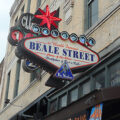by Renée S. Gordon
Native Americans occupied the region that is now Tennessee for thousands of years prior to first contact in 1541. Spanish conquistador Hernando de Soto, accompanied by approximately 600 men, some of African descent, explored westward from Florida as far as modern Memphis and the Mississippi River. It would be another 140 years before the first non-native structure, the French Fort Prudhomme, would be erected in the area.
The earliest mention of an enslaved resident is in 1760 when Abraham was sent by his master to Charleston to get help for settlers under Indian attack at Fort Loudoun. The end of the French and Indian War triggered English exploration of the region and in 1766 Colonel James Smith set out with at least one slave. Migration to the territory, filled with natural resources and river access, exploded and many of the settlers brought their slaves with them. The first census in 1790 indicates the presence of 3,417 slaves.
In 1790 North Carolina gave up her claim to the lands west of the Great Smokey Mountains and the US government renamed it the Territory of the US South of the River Ohio, or simply, the Southwest Territory. The territory was granted statehood on June 1, 1796 as the state of Tennessee. The total population numbered 77,282 with 10,613 blacks being held in bondage.
In 2011 the United States will begin a five-year commemoration of the Civil War. Sesquicentennial events, taking place throughout the country will, more than ever before, focus on civilian, ethnic, minority and lesser-known aspects of our nation’s most definitive war. Tennessee played a pivotal role and was the staging ground for more battles than any state other than Virginia. A visit to the state’s more than 700 heritage sites and 300 markers sheds light on the road to war, the war years (1861-65) and its aftermath in ways that are unique and comprehensive. www.tast.tn.org
At the onset of the Civil War 25 percent of the population, 275,719 people, were enslaved but were held by 33 percent of the white population. Most owned less than three, no owner had more than 500 and the vast majorities were held in the western section of the state. Early on the Union recognized the strategic importance of the state because control of the Tennessee and Mississippi Rivers was vital as well as the rail system.
Memphis is the natural place to begin our tour. You can fly non-stop from Philadelphia and be in the heart of it all in a few hours. The area atop a bluff was originally the site of a native village named Chucalissa. In 1818 the government acquired all of the land from the Chickasaw Indians and Overton, with his partners Andrew Jackson and James Winchester, laid out the city and named it in honor of the African city of Memphis. The city was planned with four squares, Auction, Court, Exchange and Market that all, obviously, figured in the era’s slave trade.
Memphis was, at first, a Confederate supply depot but after a victorious naval battle on June 6, 1862 General Grant made it his headquarters and it remained under Union control throughout the war. Because the Union Army in the western theater did not have a policy of liberating slaves or harboring escapees many blacks fled to Memphis for safety. This was the beginning of the community that would become a post-war thriving black Mecca in the heart of the delta. www.memphistravel.com
Legend has it that the Mississippi Delta begins in the lobby of the Peabody Hotel and ends on Catfish Row in Vicksburg. Mississippi so we’ll begin there. The 75-room Memphis Peabody Hotel was built in 1869 at a cost of $60,000. The historic landmark hotel now has 464 luxurious rooms, elegant public spaces, two bars, afternoon tea, the only Mobil four-star restaurant in the Mid-South and the famous Peabody Ducks. For more than 77-years the “March of the Ducks” has taken place at 11 AM and 5PM daily as they walk the red carpet from the fountain in the lobby to their penthouse apartment on the Peabody’s roof.
The hotel is ideally situated for visiting the city and it is only a few steps to Beale Street. www.peabodymemphis.com
One of the city’s most significant Civil War sites, the Hunt-Phelan House, was erected from 1828-32. The original two-story Federalist house is a gem designed by Robert Mills. In 1851 a two-story Greek revival portico was added. A number of US presidents and Confederate President Jefferson Davis have visited and the mansion functioned as Polk’s Confederate headquarters at the beginning of the war and later Grant’s headquarters. In the library, that still retains original pocket doors floors, he planned the Vicksburg Campaign. A tunnel beneath the home was part of the Underground Railroad and a school in the rear of house built by the Freedman’s Bureau was Memphis’ first school for African Americans.
The mansion today functions as a 10 room B&B. An African American named Nathaniel who was left in charge by the owner during a yellow fever epidemic reportedly haunts the Admiral’s Suite and the Chef’s Suite was the former kitchen and slave quarters. www.huntphelan.com
Lt. General Nathan Bedford Forrest was arguably the greatest, non-trained, Confederate cavalry commander and strategist. He was a former slave owner and trader and was one of the founders, and possibly a Grand Wizard, of the Ku Klux Klan after the Civil War.
The much protested N. B. Forrest Park is located in downtown Memphis and is the place of his internment. He was originally buried in Elmwood Cemetery in 1877 but his body was removed and placed in the new location in 1904. A life-sized equestrian statue of the man, facing south, is the centerpiece of the memorial.
In March of 2006 the Cotton Museum opened in the old Memphis Cotton Exchange Building. This museum is fantastic and an absolute must visit. The museum relates the history of cotton, its uses and impact on world history through galleries, interactive displays and a series of films. Visitors are invited to step inside a telephone booth and watch a short film, lift a cotton sack and view products, from money to dynamite, that contain cotton (Ivory floats because it contains cotton seed oil). Other highlights of the museum include Delta Blues artifacts and a mural that encircles the display area and depicts the story of blacks, the South and the relationship of cotton and slavery. www.memphiscottonmuseum.org
No Memphis tour is complete without a narrated cruise along the Mississippi River. The river travels 2300-miles from Minnesota to the Gulf of Mexico. From a river vantage point you can clearly see how the city is perched atop the bluffs and view the largest cobblestone wharf in the country. It dates from 1852 and was created with stones that were used as ballast aboard ships from Ireland.
The site of the Sultana tragedy is related. At the close of the Civil War Union soldiers, many former prisoners of war, were to sail north aboard the steamboat Sultana. The side-wheeler was designed to carry 375 people less a crew of 85 but because the 23-year old Captain James Mason, was to receive $5 per enlisted man and $10 per officer he overloaded the boat. On April 21, 1865 it sailed from New Orleans and on the evening of April 25, 1865 the Sultana and 2300 passengers docked in Memphis. At 2 AM the next morning, seven-miles outside of Memphis the boilers exploded both scalding and setting men afire. Approximately 1,700 men perished in the worst steamboat disaster in history. Ironically the incident was not well publicized because it occurred near the time of the Lincoln assassination.
Thirty-acre Tom Lee Park is on the banks of the river and is dedicated to an African American who rescued 32 people from a sinking steamboat in 1925, in his small rowboat. Once ashore he buried them up to their necks in the earth and lit a bonfire to keep them warm. For his valor the city gifted him with a house and a job for life. An obelisk was erected in 1952 and more recently a sculpture was added.
There are many wonderful restaurants in Memphis and choices may be difficult. Here are a few of my favorites all selected on the basis of creative menus, value and ambiance.
Once a department store, Felecia Suzanne’s in Downtown Memphis, opened her namesake restaurant in 2002 after working with Emeril Lagasse for eight years and co-authoring several cookbooks. The restaurant is classy and the food is classic. Patrons must try her House Smoked Deviled Eggs with Arkansas White River Caviar and her Shrimp and Grits. You won’t be disappointed. www.feliciasuzanne.com
The Rendezvous is one of the most famous barbeque rib restaurants in Memphis. It began in 1948 in a basement and continues today, serving thousands of customers daily. The Rolling Stones, Elvis and several presidents have eaten here and you can join the celebrity crowd. www.hogsfly.com
Memphis is only the start of our sesquicentennial sojourn. Join me next week as we explore several of Tennessee’s most important battlefields. In the meantime you should begin planning your own trip. www.tnvacation.com
I wish you smooth and peaceful travels!

















Leave a Comment